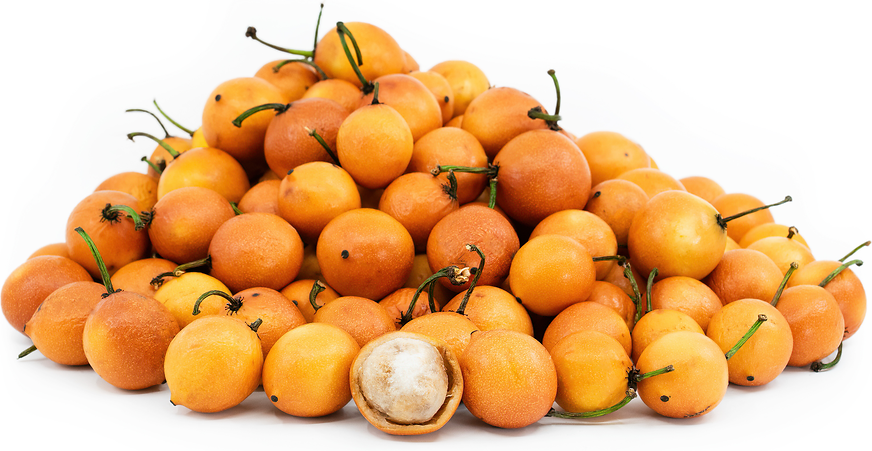


Lemon Drop Mangosteen
Estimated Inventory, lb : 0
This item was last sold on : 08/03/24
Description/Taste
Lemon Drop mangosteen is small in size, averaging 2 to 3 centimeters in length, and has a round, oblate, to ovoid shape with blunt, curved ends. The fruit’s skin is thin, smooth, and taut with a faint sheen, and when gently pressed, it will showcase a slight give. The skin can be easily peeled from the flesh, but it typically comes off in small pieces. The skin also ripens to shades of yellow-orange, red-orange, and orange, with faint spots scattered across the surface. When opened, the white pulp is fleshy, aqueous, succulent, lightly crisp, and subtly chewy. The flesh also encases 1 to 2 brown seeds in the center, and the juice has a white hue. The seeds are hard and should be discarded. Lemon Drop mangosteen releases a tropical aroma when peeled, and the flesh is consumed ripe, bearing a bright, acidic, sweet, sour, and tropical taste with pineapple and citrus nuances.
Seasons/Availability
Lemon Drop mangosteen is available between June and September. The fruits are found year-round in some regions of Mexico and Central America.
Current Facts
Lemon Drop mangosteen, botanically classified as Garcinia intermedia, is a tropical species belonging to the Clusiaceae family. The small fruits grow on evergreen trees extending 5 to 10 meters in height, and in some regions, the trees may reach up to 20 meters. Lemon Drop mangosteen are rare fruits, as they are only produced in limited quantities, and the trees are mainly planted as an ornamental in home gardens. The species is also found in the wild and is fast-growing, adaptable, and produces high yields. Lemon Drop mangosteen trees begin bearing fruit approximately two years after sowing, and the fruits are primarily eaten fresh, savored for their unusual, tropical, sweet, and sour taste. There is also a variant of Lemon Drop mangosteen, called Orange Lemon Drop mangosteen, that is often generally labeled as Lemon Drop in local markets and has stronger orange hues on the fruit’s exterior.
Nutritional Value
Lemon Drop mangosteen has not been extensively studied for its nutritional properties. Limited sources mention that the fruits may be a source of fiber to regulate the digestive tract, vitamin C to strengthen the immune system, and B vitamins to help maintain overall bodily health. The fruits also provide some zeaxanthin, lutein, and beta-carotene, organic pigments known as carotenoids that are said to help maintain eye health.
Applications
Lemon Drop mangosteen has a tangy, sweet, and bright flavor suited for fresh and cooked preparations. Use of the small fruits is limited, and it is mostly reported that the fruits are consumed out of hand. Eating fresh Lemon Drop mangosteen allows consumers to appreciate the fruit's dynamic, refreshing, sweet, and sour taste. The fruits can be easily peeled by hand, discarding the skin and seeds. Lemon Drop mangosteen can also be peeled and tossed into salads, added to fruit medleys, or served on fruit platters as an appetizer. In addition to eating the fruit out of hand, Lemon Drop mangosteen is popularly blended into various beverages, including juices and smoothies. The fruits are also pureed and frozen into yogurts, ice cream, and other desserts. Beyond fresh uses, the species can be simmered into jams, jellies, and syrups for extended use. Lemon Drop mangosteen has a short shelf life and should be immediately consumed for the best quality and flavor.
Ethnic/Cultural Info
Lemon Drop mangosteen is known by many names worldwide. Even within their native range across Central America and Mexico, the fruits are called by several regional names. In Mexico, Lemon Drop mangosteen is known as Toronjil, Mamellito, Zapotillo, Chichi de Mono, Patácua, and Ishbastié, while in Guatemala they are known as Pale de Fruitilla and Arrayan. In Honduras, the fruits are called Caimito de Montaña, and in Costa Rica, they are known as Sastra, Jorco, Mameyito, and Mangostán. It is important to note that despite their mangosteen moniker, this species is distinct from the purple-skinned Garcinia mangostana, the fruit typically known as mangosteen in Asia. Several species within the Garcinia species are referred to as mangosteen, which can sometimes make distinguishing the fruits in local markets challenging. Garcinia intermedia is also distinct from Garcinia madruno, another Garcinia species that is called Lemon Drop in some regions of the Americas.
Geography/History
Lemon Drop mangosteen is a part of Garcinia intermedia, a species said to be native to tropical regions of Mexico, Central America, and portions of northwestern South America. The species has been growing wild since ancient times and thrives in warm, humid climates up to 1,219 meters in elevation. Throughout history, Lemon Drop mangosteen has remained a mostly wild species and was planted in home gardens in some regions as an ornamental. The species was later introduced to Asia, where it is grown on a small scale. Today, Lemon Drop mangosteen is being evaluated as a potential commercial crop and is produced in limited quantities throughout the Americas. When in season, the fruits are sold through local markets in their growing regions and through select distributors. The fruits are considered a delicacy and are sold fresh.




